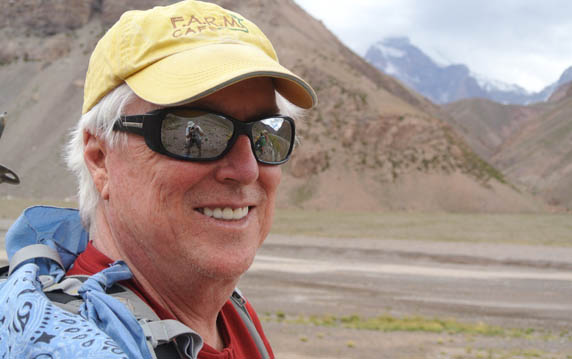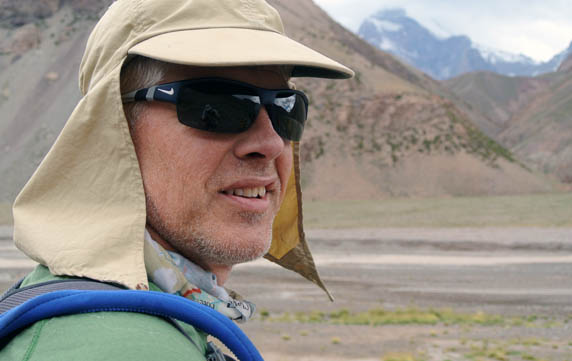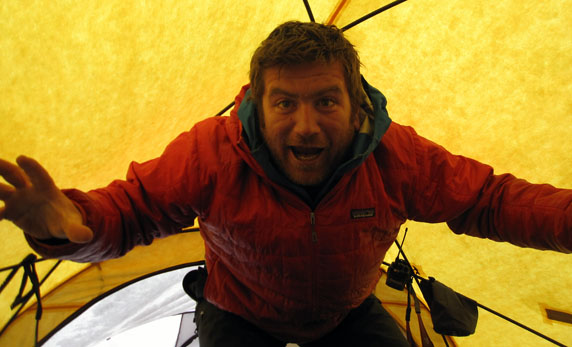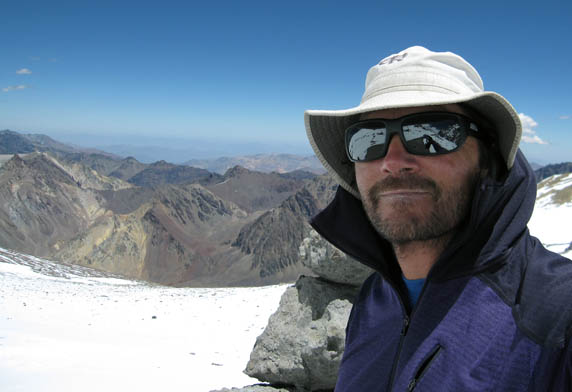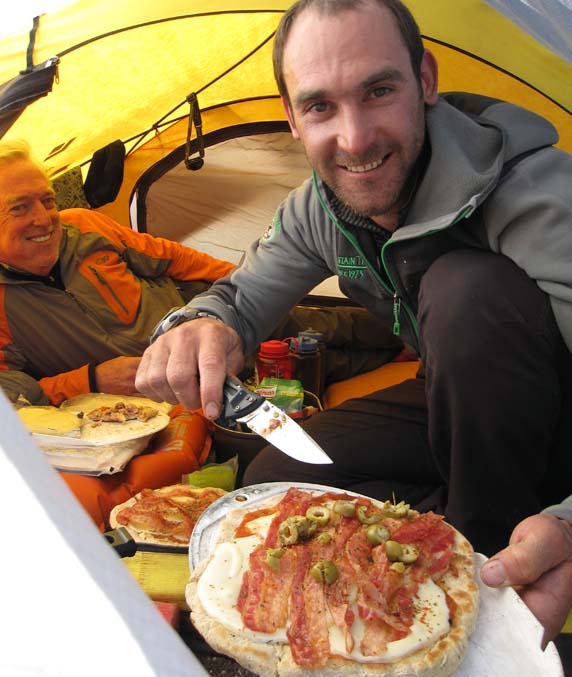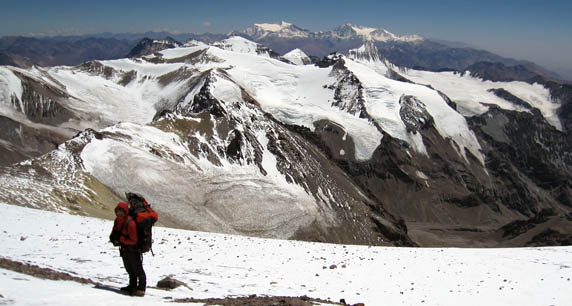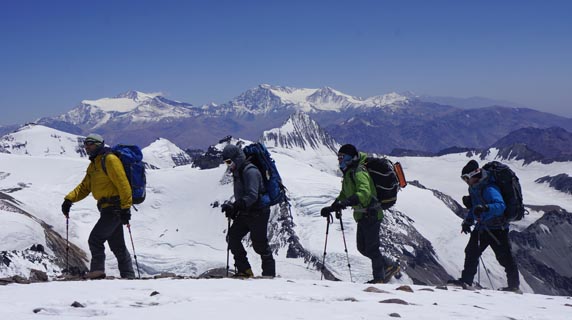Well, we are all back, following our climb and traverse of the highest peak in South America. As I attempt to process the experience from the comfort of my home and warm office, I’m struck by what a challenging trip we had, and how some of the biggest challenges were not of the physical kind… We made a number of new friends along the way, and this post will attempt to recap some of the layers of experiences that forged five climbers from different parts of the world, and from different backgrounds, into a team that was able to work together as we attempted to climb to the top of the continent.
Our team consisted of Wayne Miller, Mike Browne, Barry Kennedy, our guide Fermin Avila and me, Todd Rutledge.
The day we met in Mendoza was a hot one, and it felt good to make the drive up to Penitentes, the small ski resort near the trailhead to the Vacas Valley. We spent one night at Penitentes after organizing our kit into loads that would be carried up the valley by mules. The “Rol de Cordero” that we all ordered for dinner that evening was one of the best dishes we ate in a country known for having some tasty food!
After a short drive to the trailhead and the completion of some paperwork with the “Guardeparques” (Park Rangers), we began our trek into the mountain. Over the next three days, we hiked about 8 miles a day, carrying light daypacks with our food, water and essentials, while our team of “arrieros” (mule drivers) transported the bulk of our kit to Base Camp.
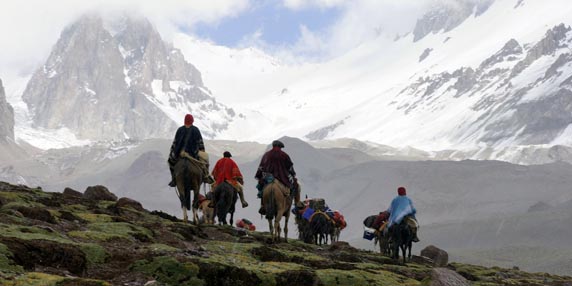
Our team of “arrieros” (mule drivers) not only transported the bulk of our supplies and gear to Base Camp, they were also our friends, dinner companions and grill masters for a traditional “asado” (mixed grill of meats).
The weather provided us a little bit of most everything on our hike to Base Camp. We had HOT sunny stretches with little wind to cool us off, but most of the time we had at least a light breeze to keep us a bit cooler. At Casa de Piedras, the site of our second night’s camp on the approach, we were deluged with a heavy downpour and accompanying lightning and thunder, something almost unheard of for the area.
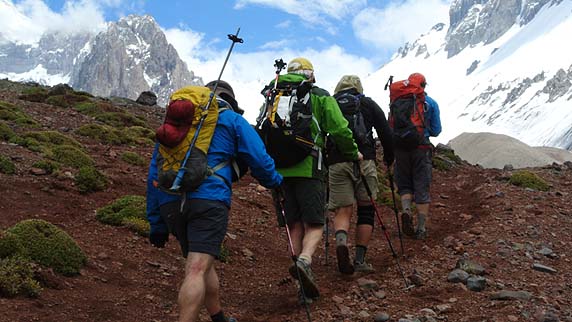
The team, approaching our Base Camp at Plaza Argentina, after hiking up the steep and narrow Relinchos Valley.
At the end of a 7-hour hike on our third day, we climbed up a bit of glacial moraine and arrived at the bustling Plaza Argentina Base Camp, our home for the next four nights. Our friends from Fernando Grajales Base Camp service kept us well fed and happy during tour stay at the camp.
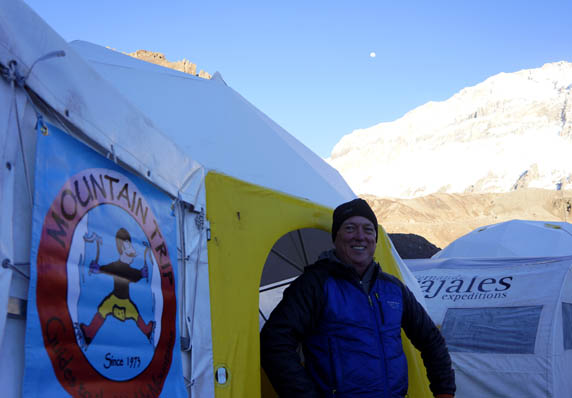
Wayne, outside our base camp tent, where we ate well and sought shelter from the winds that pummeled us on occasion, as we built up our acclimatization in preparation for the upper mountain.
Acclimatization is critically important on a climb like Aconcagua. We saw numerous other teams, and many had very different ideas about how to best acclimatize or how much time to spend at different elevations. Our program seemed to work quite well for our group, and after four nights at 4200m, we were ready to move up onto the upper mountain. It took us about 4 hours to make the move up to the site of our Camp 1, which was a bit higher than the majority of the other teams, which we could see camped below us. Being a bit higher allowed us to be closer to the source of our water, and we felt we were a bit more protected from the wind than the other sites. The wind began to blow and while we sure noticed it blowing, our single-walled Black Diamond tents were strong and quiet. A couple other teams lost tents to the wind from the lower camp sites, but our tents hung toiugh!
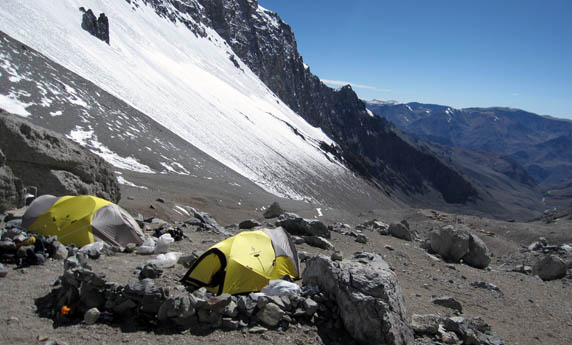
Camp 1 afforded us some huge views to the east. The rock walls helped protect our tents from the often intense winds. Two other teams lost tents at this camp while we were there, as a result of the winds!
We spent one extra day at Camp 1, while we watched the wind rip through the col (saddle) that separates Aconcagua from it’s neighbor, the 19,300′ Cerro Ameghino. Our route took us through the col, and as we watched the wind rip plumes of snow a half mile from the saddle, we decided that we’d just sit tight and acclimatize for an extra day. The following day the wind had not abated much, but the temperature had risen, so we opted to pack up some of our kit and go for a hike up towards the col. We didn’t expect to actually make it through the saddle, as the winds looked pretty tough, but we thought we’d see how far we could get before the temperature dropped or the winds turned us back.
Well… the winds certainly did not disappoint us! We pushed hard to get up into the col, but we were bent forward over our ski poles, bracing as gusts quite literally threatened to lift us off our feet! Still, the temperature never got cold, and it was sort of fun (in a really twisted way) to see how far we could push it into the face of such blasts. After being thumped around for a bit, we cached our supplies and equipment under a pile of rocks, just below the col, and retreated back to the relative shelter of our tents.
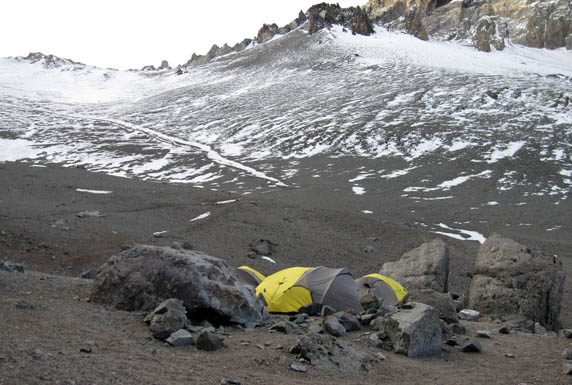
Looking up the route from the site of our Camp 1. The route is fairly easy to see above camp, as it climbs up from left to right.
The following day, we pushed up from Camp 1 to 18,000′ and the site of our Camp 2. We had to push through a bit of wind right below the entrance to the col, but once we crested the saddle, the wind diminished and we enjoyed our hike into camp. Camp 2 was bustling when we first arrived, with 31 tents set up. Our friends Jacob Schmitz and Duncan Stuart were there to greet us, as they finished their 8-day stint of waiting for a window to move to high camp (they finally moved up and summitted just a couple of days before we moved high).
Highlights from Camp 2 included numerous delicious meals, including hand made pizzas, and 1.5″ thick steak sandwiches, in addition to sublime evening light, and a snow squall that dumped almost a foot of snow on our tents. The snow storm included a fair bit of thunder and while walking to the edge of camp to relieve myself, I felt a bizarre tingling sensation on my head and shoulders, as I became electrically charged. Needless to say, I bid a hasty retreat to my tent and the seeming protection of my P-bottle, instead of braving the storm…
Up to this point, we had been roughly parallel a few other teams. We had all been looking carefully at the forecast, which had shown pretty high winds on the upper mountain for several days. The models looked pretty good for Tuesday the 28th of January, but even better for the following day. We were the only team of the several that were on the same basic schedule to have extra time planned for additional contingency days, so we bid “adios” to the other guided parties, as they moved up on Monday, whilst we waited an extra day at Camp 2, confident that Wednesday would give us better conditions for a summit bid than the other teams. Our extra day enabled us to further develop our acclimatization as well.
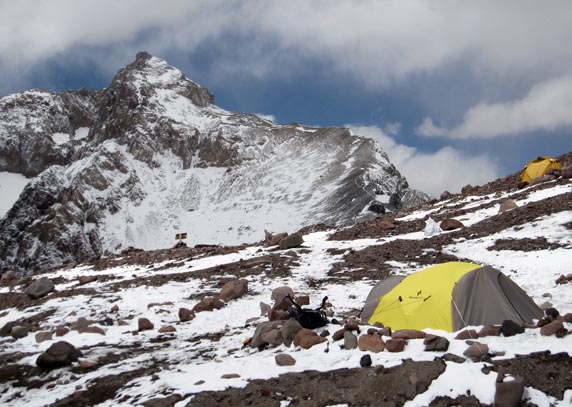
Camp 2 on our route is also known as “Camp 3 Guanacos,” after it’s sequence on the old, Guanacos Valley route that has been closed for several years. It is also known as “Chopper Camp,” as there used to be the remains of a crashed helicopter just above camp.
On Tuesday, we packed up our camp and pushed up to our high camp, located on the north ridge of the mountain, at an elevation of about 20,000′. The day was a bit breezy as we hiked up, and we were all bundled up and moving as quickly as possible to stay warm. At camp, we met numerous climbers who had tried to summit that day, and it seemed like most had not made it, due to the cold, windy conditions of the early morning. We crossed our fingers and hoped for a calm morning, as had been forecasted…
We awoke at 04:00 and began our preparations for a pre-dawn start to our summit bid. No one slept well that night, in part because we were excited about heading high, but also because it is just plain tough to sleep at 20,000′. We dressed and piled into Fermin’s tent for hot drinks and breakfast.
After eating what bacon quesadillas, oatmeal and cereal we could, and fueled by mugs of hot coffee and cocoa, we could procrastinate no longer, so we left the dining tent and finished suiting up for our hike to the top. Cold fingers made strapping crampons onto our boots a chore, but the sky was crystal clear and there was hardly a breath of wind. Our patience seemed to have paid off!
Layered in our warm clothes and expedition parkas, we departed high camp by headlamp, moving slowly upward, our world seemingly limited to what we could see in the pale glow of our lights. About a hundred meters our of camp, Mike told us that he was experiencing some symptoms that required my attention. After a consult and assessment, we decided that it was prudent for him to return to high camp. He and I descended back to camp, while the other members of our team continued their push to the top.
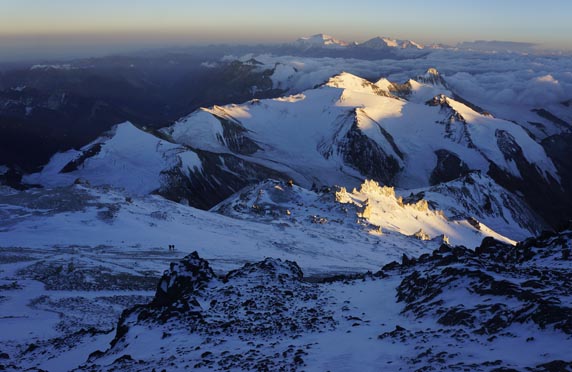
Looking down at high camp from roughly an hour into our summit morning. The sun had just begun to bathe the mountain in it’s warmth, which was welcomed in the cold morning.
Barry, Wayne and Fermin made great time as they climbed up the north ridge and traversed over to the west side of the mountain. The morning was very cold, but as there was virtually no wind, it was pretty easy to manage the cold. They caught up with, and passed several other teams, but all in all, there were not too many other climbers attempting the summit that morning.
The notorious “Canaleta,” the moderately steep gully that acts as the gatekeeper for the summit, was snow filled and not too difficult, as the climbers’ crampons provided solid traction on their ascent. At the top of the Canaleta, they took a moment to look over the crest of the summit ridge and down the massive South Face of the mountain, which dramatically fell thousands of meters below them.
At last, they scrambled the last feet onto the small summit plateau, where cameras were drawn and photos snapped, while the climbers enjoyed the clear, stillness of their time on the top of South America. They put forth a tremendous effort, but they still needed to descend, so they didn’t spend too much time on the summit. On their descent, they really made great time, reaching high camp in just under two hours.
After resting and re-hydrating at high camp, they decided that they would rather keep moving than spend another night at 20,000′, so they quickly packed up and descended all the way down to join Mike and I at Plaza de Mulas, the Base Camp on the west side of the mountain. Mike and I had descended earlier in the day, and Mike’s symptoms had improved considerably after we arrived at Plaza de Mulas.
Plaza de Mulas felt like a city after our time on the mountain. We had a blast talking with climbers from around the world, and feasting on more delicious steaks. The following morning, Wayne and Barry decided that they would take the offer of a helicopter ride out to the Horcones Valley trailhead, while Fermin, Mike and I hiked out the 16 or so miles.
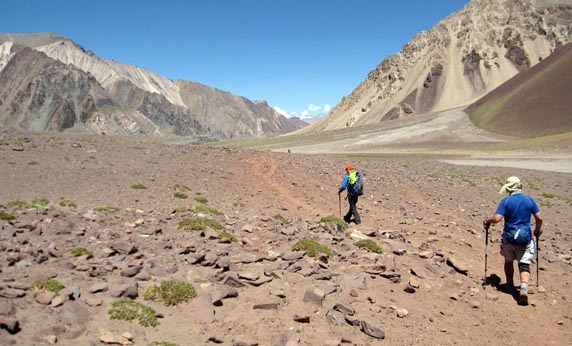
The hike out the Horcones Vally took roughly seven hours, which left us plenty of time to take in the stunning scenery.
The entire team was reunited at the Penitentes ski resort, and we quickly loaded up our van and made the drive back to Mendoza, eager for soft beds and tender steak dinners! We stopped along the way for food and beverages, and rolled into Mendoza not long after the sun went down.
The team did great and each climber should be proud of his efforts. We climbed up and over the highest peak in South America and had a lot of fun in the process. The sound bites and memories that keep popping into my head as I write could fill a book, but I hope that some small sliver of our collective experience is conveyed by this short recap of our adventure.
I’d like to extend a heart felt thank you to all of our climbers, who entrusted Mountain Trip with helping them on this expedition. I’d also like to thank Fernando Grajales Expeditions for all of his staff’s support and help during our trip. I’ve known Fernando for almost 20 years and am impressed at his attentiveness and level of service, and am proud to call him un amigo. Thanks to Carlos for driving us to Penitentes, Marcelo for the drive back to Mendoza, the Base Camp staff at both Plaza Argentina and Plaza de Mulas (Griselda, Anita, Julincha, Pablo, and all the others whose names are escaping me at present), the Arrieros who transported our kit up and down the long, dry valleys, and to our friends who work tirelessly as porters on the mountain (Cabeza, Turco, Sebastian, and Ali). You guys are animals!
Hasta la proxima y un abrazo muy grande!
Todd Rutledge
Ophir, CO

